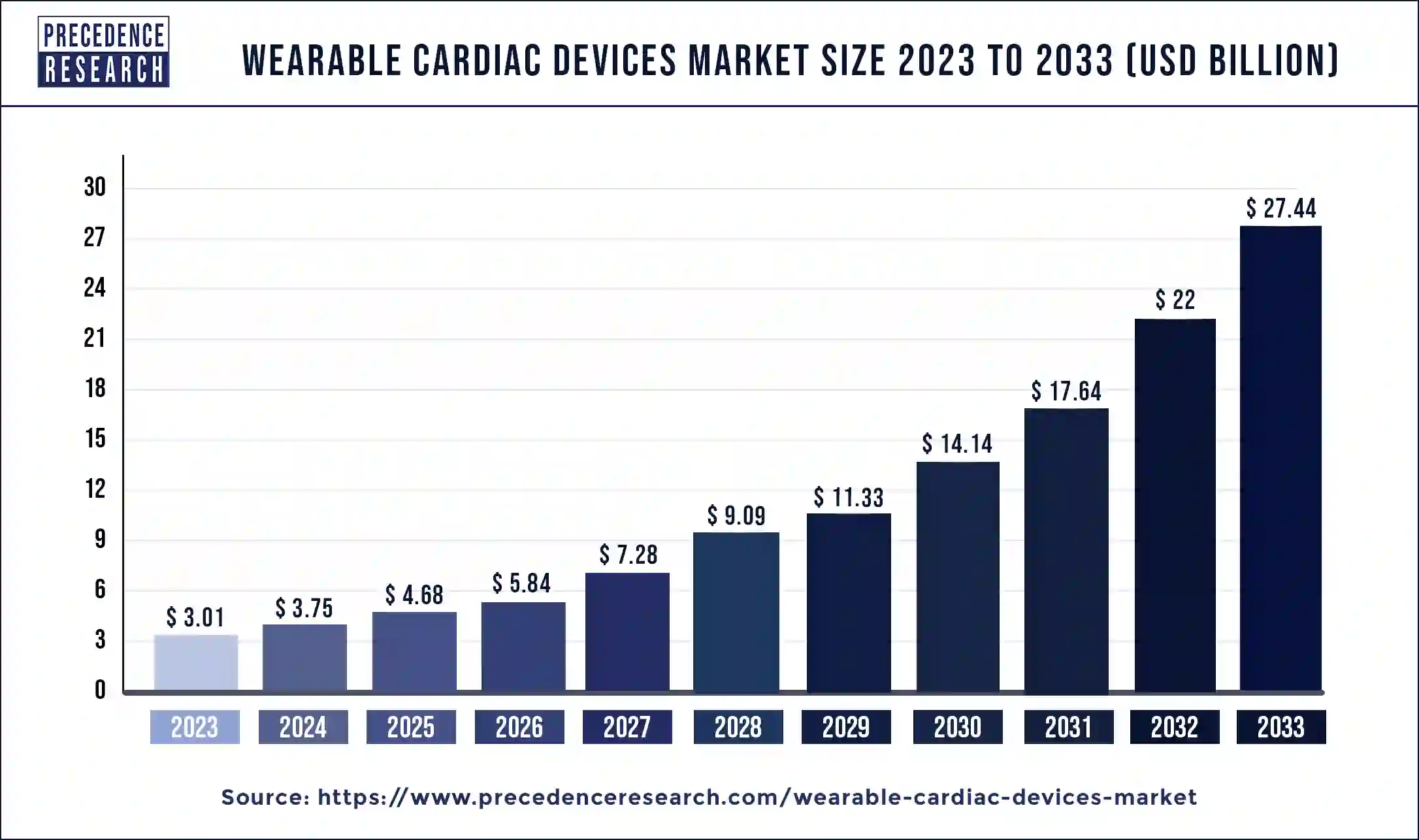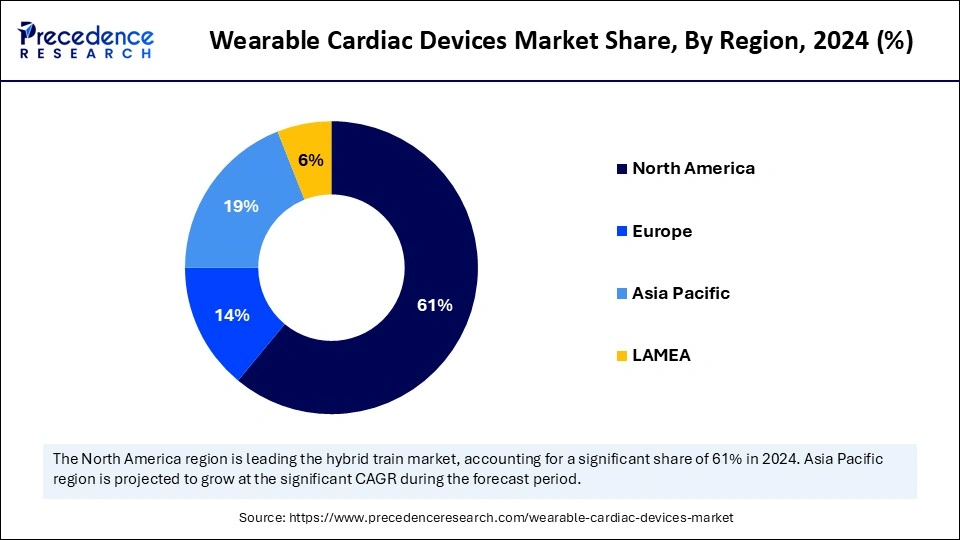January 2025
Wearable Cardiac Devices Market (By Product: Defibrillator, Holter monitors, Patch, Others; By Application: Home Healthcare, Remote Patient Monitoring, Others) - Global Industry Analysis, Size, Share, Growth, Trends, Regional Outlook, and Forecast 2024-2033
The global wearable cardiac devices market size was valued at USD 3.01 billion in 2023 and is anticipated to reach around USD 27.44 billion by 2033, growing at a CAGR of 24.73% from 2024 to 2033. The rising awareness and surging expenditure on health by the population is boosting the growth of the market.

The U.S. wearable cardiac devices market size was estimated at USD 1.38 billion in 2023 and is predicted to be worth around USD 12.74 billion by 2033 with a CAGR of 24.89% from 2024 to 2033.

North America led the wearable cardiac devices market with the largest market share in 2023. The market growth in the region is attributed to the rising cases of cardiac-related diseases in the population due to lifestyle habits and aging factors. The rising geriatric population is one of the major reasons for the higher number of chronic cardiovascular diseases in the region. The population's early adoption of technology in healthcare and the well-developed healthcare infrastructure are driving the expansion of the cardiovascular treatment ratio. The higher availability of the leading technology companies participating in the development of wearable healthcare devices contributes to the growth of the wearable cardiac devices market in the region.

Asia Pacific is expected to witness the fastest growth in the market during the forecast period. The growth is owing to the expansion in population in the region's countries like India and China. The increasing prevalence of cardiac diseases in the population is driving the demand for regular health monitoring devices.
Additionally, the rising technological trend in healthcare wearable devices is driving the growth of the wearable cardiac devices market across the region. About 5–6 lakh Indians are thought to pass away from sudden cardiac death (SCD) each year, with a significant percentage of those deaths occurring in those under 50. In India, stroke ranks as the second most prevalent cause of death. In India, there are over 1,85,000 recorded stroke cases annually, with one stroke fatality occurring every four minutes and a stroke occurring every forty seconds.
The critical emphasis now turns to improving cardiac-related illness monitoring, early identification, and prevention tactics in light of these concerning developments. Indian cardiac care is undergoing a fundamental transformation thanks to recent technological developments. The emergence of smart gadgets has brought about a transformation in the field of cardiac care by providing more options for managing daily health. These developments provide people the ability to actively engage in their healthcare process and give medical professionals vital resources for better monitoring and treating heart issues.
The Asia Pacific wearable cardiac devices market size was calculated at USD 570 million in 2023 and is projected to expand around USD 5,350 million by 2033, poised to grow at a CAGR of 25.09% from 2024 to 2033.
| Forecast Year | Market Size in USD |
| 2023 | $570 Million |
| 2024 | $710 Million |
| 2025 | $710 Million |
| 2026 | $1,110 Million |
| 2027 | $1,380 Million |
| 2028 | $1,730 Million |
| 2029 | $2,150 Million |
| 2030 | $2,690 Million |
| 2031 | $3,350 Million |
| 2032 | $4,180 Million |
| 2033 | $5,350 Million |
Wearable Cardiac Devices Market Overview
Wearable cardiac devices are one of the segments of wearable healthcare devices that are used to monitor and track the physical activity of patients suffering from any type of cardiac issues. Wearable devices are used to capture data by mobile sensors and generate behavioral and physiological insights like heart rate, physical activity, sleep, and heart rhythm. Wearable devices are minimally invasive and used for the diagnostics process.
The rising popularity of wearable healthcare devices is driving the demand for the wearable cardiac devices market. It helps in positively influencing lifestyle changes such as prevention measures, remote monitoring of patients, and arrhythmia screening of at-risk individuals with peripheral artery diseases and other chronic cardiovascular disorders. The rising geriatric population and the accepting sedentary lifestyle are causing an increased number of cardiac issues in people, driving the demand for the wearable cardiac devices market.
| Report Coverage | Details |
| Wearable Cardiac Devices Market Size in 2023 | USD 3.01 Billion |
| Wearable Cardiac Devices Market Size in 2024 | USD 3.75 Billion |
| Wearable Cardiac Devices Market Size by 2033 | USD 27.44 Billion |
| Wearable Cardiac Devices Market Growth Rate | CAGR of 24.73% from 2024 to 2033 |
| Largest Market | North America |
| Base Year | 2023 |
| Forecast Period | 2024 to 2033 |
| Segments Covered | Product, Application, and Regions |
| Regions Covered | North America, Europe, Asia-Pacific, Latin America, and Middle East & Africa |
Driver: Rising cases of cardiovascular diseases (CVD)
The rising chronic diseases like cardiovascular diseases, diabetes, and respiratory illness in the population due to the changing life standards, eating and sleeping habits, rising consumption of alcohol, and smoking increase the risk of chronic illness in the population. The increase in the geriatric population globally is one of the major factors that drive cardiovascular disease cases.
The increasing popularity of wearable devices in the healthcare industry is due to their beneficial properties, like healthcare monitoring and real-time insights into patient health. Wearable technology allows us to tackle cardiovascular diseases by personalizing atrial fibrillation management, refining stroke prevention strategies, and maintaining the physician-patient relationship. Thus, the rising awareness about wearable healthcare technologies is driving the growth of the wearable cardiac devices market.
For instance, cardiovascular diseases are the leading cause of death in the world. Among the total population, 620 million people live with circulatory and heart diseases worldwide. Every year, approximately 60 million people develop a circulatory or heart disease, which leads to 1 in 3 deaths globally.
Restraint: Regularities issues
The wearable cardiac devices market faces challenges in various regional markets due to strict regulations and lower awareness about these devices. Many countries have stringent regulations regarding adopting wearable healthcare devices, citing concerns about their accuracy. Additionally, limited awareness among the population about the benefits and capabilities of wearable cardiac devices hinders their widespread adoption.
This lack of understanding and acceptance contributes to the slower market growth in these regions. Overcoming these challenges will require efforts to educate healthcare professionals and the general public about the potential advantages of wearable cardiac devices and work towards meeting regulatory standards. By addressing these issues, the market for wearable cardiac devices may see increased acceptance and growth in regions where such challenges currently exist.
Technological advancements in wearable cardiac devices help enhance the efficiency and accuracy of health monitoring systems. It improves the patient and physician experience by collecting data and monitoring ECG-based cardiac activities. The latest wearable cardiac devices can be worn all seven days, anywhere, due to their compact size, water resistance, lightweight, and disposable properties.
The advancements in wearable devices offer great efficiency and save time for both patients and physicians. It has the ability to track any symptoms without any issues. The rising geriatric population and the pandemic drive the sustainable growth of wearable cardiac devices in the global market due to the rising demand for home healthcare. Additionally, the increasing participation of major technology leading companies in wearable healthcare devices is further driving the opportunity for the wearable cardiac devices market.
The defibrillators segment dominated the wearable cardiac devices market during the forecast period. The increasing acceptance of cardioverter-defibrillators is enhancing the efficiency of monitoring and increases the survival rate at high risk of sudden cardiac death from ventricular tachyarrhythmia. The devices are responsible for continuous recording and transmission via modem in both bradyarrhythmias and tachyarrhythmia. Clinical studies state that wearable defibrillators had higher efficiency in terminating ventricular fibrillation (VF) and ventricular tachycardia (VT). Thus, the higher efficiency and accuracy of devices drive the expansion of the wearable defibrillator segment.
The home healthcare segment dominates the wearable cardiac devices market and is expected to grow at the fastest rate during the forecast period. The increasing preference for home healthcare in the population at the time of the outburst of the COVID-19 pandemic is contributing to the growth of the segment. Wearable devices allow monitoring and tracking of healthcare data and provide valuable insights to physicians from anywhere, resulting in a reduction in hospital visits. The rising awareness about wearable healthcare technology in people minimizes routine hospital visits and enhances the home healthcare segment.
Segments Covered in the Report
By Product
By Application
By Geography
For inquiries regarding discounts, bulk purchases, or customization requests, please contact us at sales@precedenceresearch.com
No cookie-cutter, only authentic analysis – take the 1st step to become a Precedence Research client
January 2025
January 2025
December 2024
March 2024